Questões sobre Interpretação de Texto
Lista completa de Questões sobre Interpretação de Texto para resolução totalmente grátis. Selecione os assuntos no filtro de questões e comece a resolver exercícios.
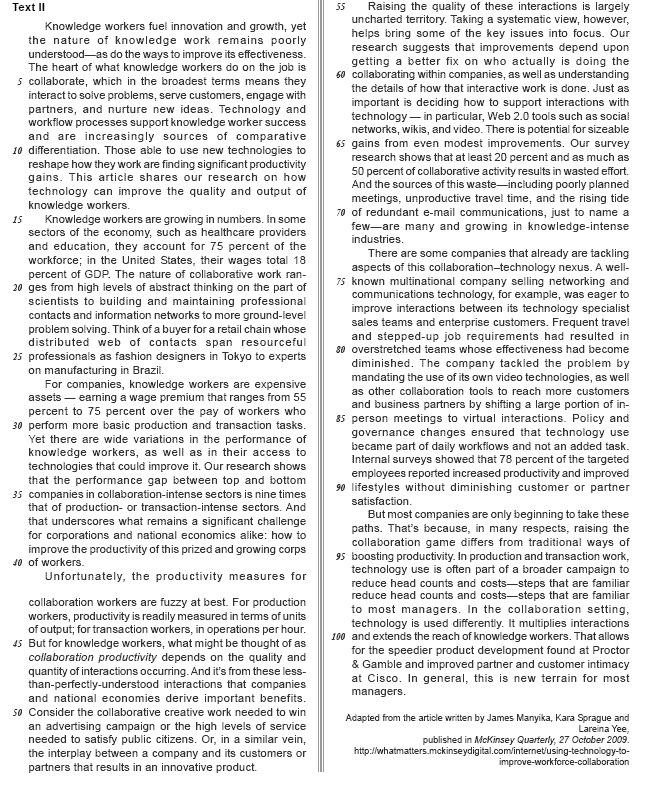
As far as policy changes are concerned, the multinational company introduced in paragraph 6 (lines 73-91)
- A.
decided to enhance communicative effectiveness of part of its workforce and external clients using some Web 2.0 tools.
- B.
invested over $100 million in flight tickets and hotel stays so as to discuss the use of collaboration tools with its business partners.
- C.
managed to save on overall company expenditure over a period of eighteen months as it eliminated negotiations with far-away nations.
- D.
increased customer satisfaction as a result of its implementation of a renewable energy project that was part of a greener company governance program.
- E.
cut down on carbon emissions merely by implementing virtual collaborative tools since the workers now had the chance to skip work and enjoy a better lifestyle.
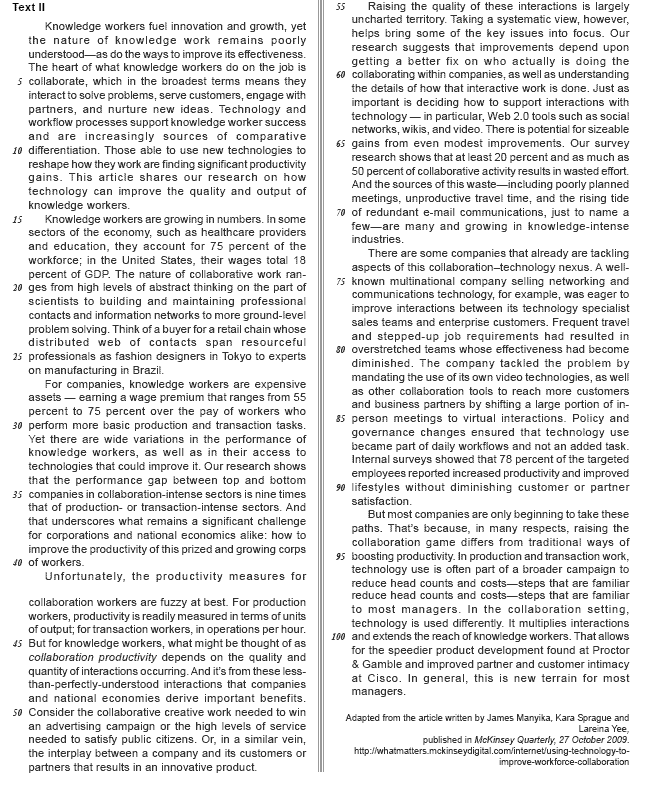
Considering the sentence "Frequent travel and stepped-up job requirements had resulted in overstretched teams whose effectiveness had become diminished." (lines 78-81), all of the following statements are true, EXCEPT
- A.
a specific set of employees had escalating demands at work.
- B.
the performance of the stressed teams of employees had decreased.
- C.
workers with intense workloads were getting stressed and letting down in efficiency.
- D.
some workers in the company were constantly away from their offices on business trips.
- E.
teams that were working on the same project were stretched out in different parts of the world.
"The agency model presumes the employer is able to accurately measure employee performance. Yet measuring performance is always difficult, and in knowledge work it is especially difficult. If you have no real chance of observing, understanding, or attributing the results of employee work, you become much more dependent on employees' willingness to openly communicate the meaning of their work."
Robert Austin in http://sciencecareers.sciencemag.org/
career_development/previous_issues/
articles/1470/managing_knowledge_workers/
The extract above is in tune with Text II because it
- A.
defines what the agency model is and discusses how companies control the contribution of each employee.
- B.
discusses top priorities in defining what knowledge workers should do to add meaning to their persona lives.
- C.
asserts that defining which criteria to adopt in assessing a knowledge worker's output on the job is not a straightforward task.
- D.
argues that employees need not openly discuss their observations and results in order to be evaluated on their contributions to the company.
- E.
emphasizes that it is important to have company staff members communicate what they do so that managers can check if they have free time.
The authors use exemplification in many parts of the text in order to clarify their ideas. Mark the option that indicates the correct relationship between the examples and the issue being illustrated.
- A.
"...interact to solve problems, serve customers, engage with partners, and nurture new ideas." (lines 6-7) are examples of tasks performed by knowledge workers.
- B.
"...healthcare providers and education," (lines 16-17) are examples of sectors of the economy with few knowledge workers.
- C.
"in operations per hour." (line 44) is an example of how collaboration workers are measured.
- D.
"...the collaborative creative work needed to win an advertising campaign or the high levels of service needed to satisfy public citizens." (lines 50-52) are examples of tasks performed by production workers.
- E.
"...poorly planned meetings, unproductive travel time, and the rising tide of redundant e-mail communications," (lines 68-70) examples of effective collaboration within companies.
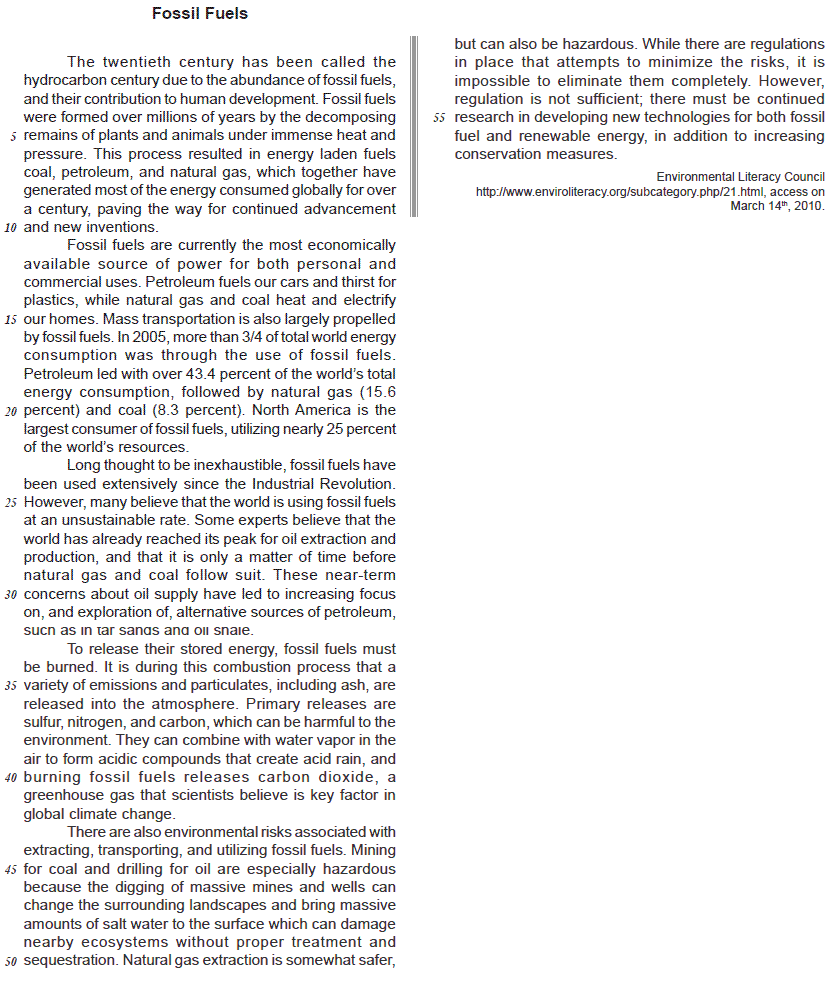
The text Fossil fuels can be classified as a
- A.
recommendation for future use and transport of fossil fuels.
- B.
manual for the recycling of fossil fuels consumed in industries.
- C.
panoramic account of the past, present and future of fossil fuels in society.
- D.
historical perspective of world energetic resources before the Industrial Revolution.
- E.
newspaper article on recent discoveries in oil drilling and their economic potential.
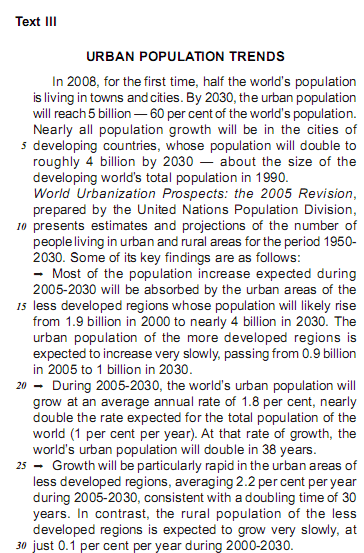
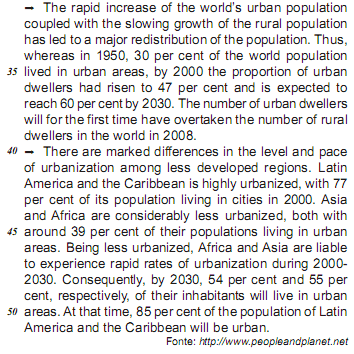
The author's communicative intention in Text III is to
- A.
criticize the devastating impact of the sudden urban growth on the world's rural population.
- B.
provide solutions to the accelerated population increase in the less developed regions of the world.
- C.
list some projections for the world's population growth in rural and metropolitan areas in the next decades.
- D.
compare the developed regions of the world that are ikely to suffer from the substantial population growth in urban areas.
- E.
identify the reasons why the percentage of urban dwellers in developed regions will not increase in the same proportion in less developed areas.
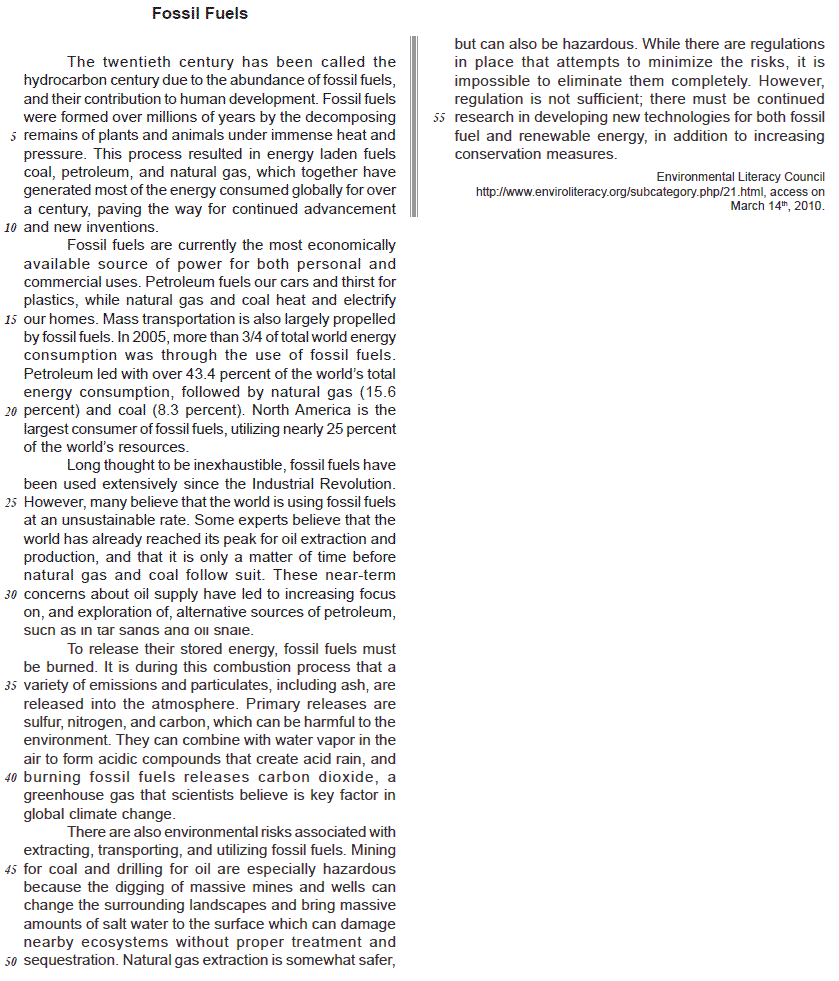
In The twentieth century has been called the hydrocarbon century due to the abundance of fossil fuels, and their contribution to human development. (lines 1-3), due to can be substituted by
- A.
such as
- B.
besides
- C.
in spite of
- D.
instead of
- E.
because of
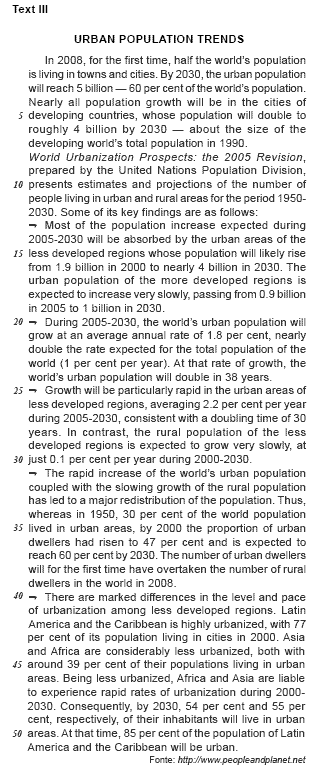
The only correct conclusion we may derive from Text III is that, by 2030,
- A.
the world's rural population in developing countries is unlikely to have grown at all.
- B.
Africa and Asia will probably face a very slow increase in the total number of their city dwellers.
- C.
Latin America and the Caribbean are expected to face a very dramatic rise in their urban population rates.
- D.
less developed regions of the globe will have around twice as many urban inhabitants than thirty years before.
- E.
the world's urban population in more developed nations will certainly stagnate, remaining in the same levels as in 1990.
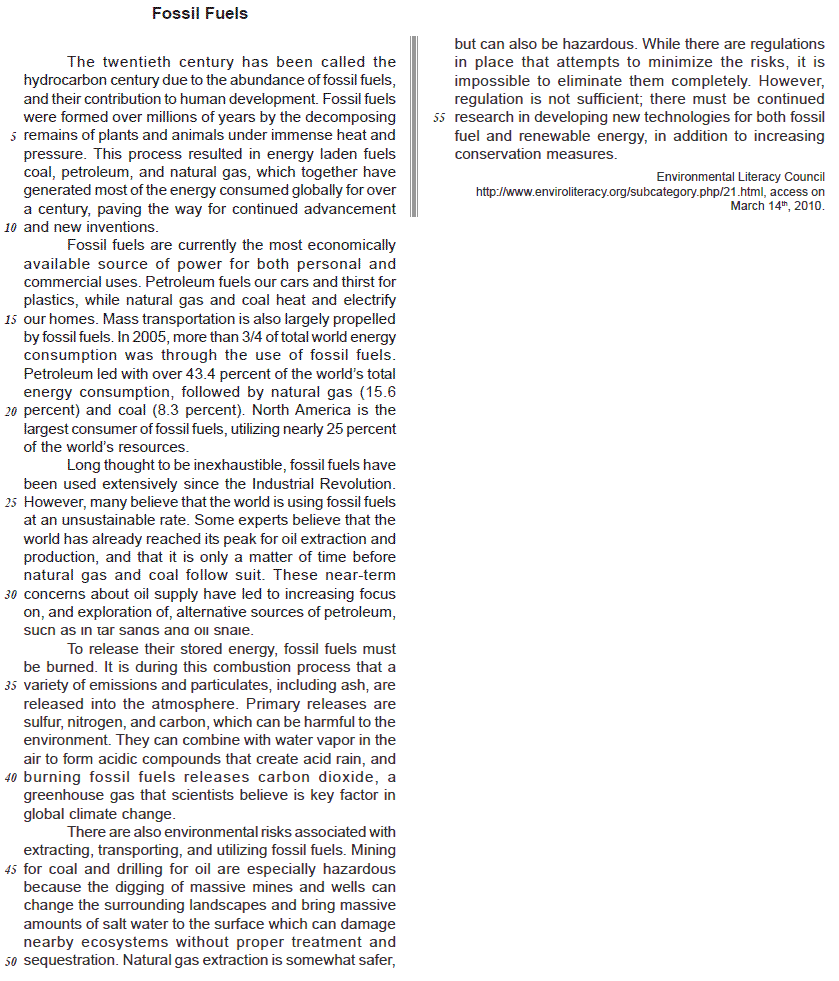
This process... (line 6) refers to the
- A.
decrease of the energy produced by fossil fuels.
- B.
discovery of natural resources millions of year ago.
- C.
artificial decomposition of plants, animals and natural gas.
- D.
disintegration of plants and animals under extremely cold conditions.
- E.
deterioration of the remains of living beings caused by heat and pressure.
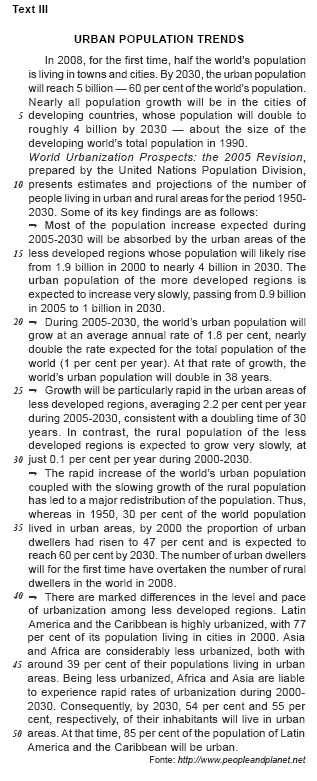
"Although predicting the future is always risky, we can be fairly certain of the general trends now expected in global population in the next few decades. The world will add billions to its population, through additions made almost exclusively in the world's poorer nations. This can only be expected, since developing countries already represent most of the world's population. These anticipated changes, that now seem almost inevitable, loom large as the backdrop against which today's policy choices are to be made, both in and out of government."
Global and U.S. National Population Trends - by Carl Haub Consequences. Vol. 1, No. 2, Summer 1995.
The only passage in Text III that directly supports the predictions anticipated in the fragment above is
- A.
"By 2030, the urban population will reach 5 billion – 60 per cent of the world's population." (lines 2-3).
- B.
"Most of the population increase expected during 2005-2030 will be absorbed by the urban areas of the less developed regions whose population will likely rise from 1.9 billion in 2000 to nearly 4 billion in 2030." (lines 13-16).
- C.
"During 2005-2030, the world's urban population will grow at an average annual rate of 1.8 per cent, nearly double the rate expected for the total population of the world (1 per cent per year)." (lines 20-23).
- D.
"In contrast, the rural population of the less developed regions is expected to grow very slowly, at just 0.1 per cent per year during 2000-2030." (lines 28-30).
- E.
"The rapid increase of the world's urban population coupled with the slowing growth of the rural population has led to a major redistribution of the population." (lines 31-33).


